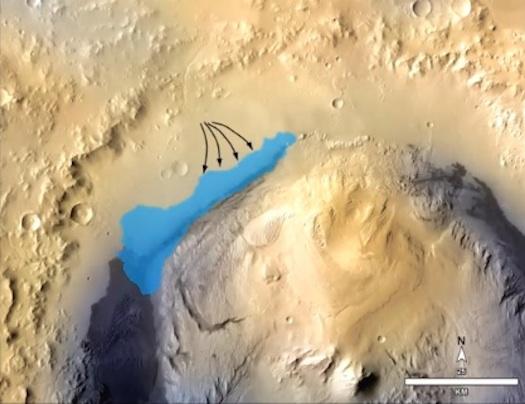Curiosity Finds A Lake Bed On Mars, Though Drowning Isn’t An Issue
This article is more than 2 years old

Okay, so it actually found the spot where a lake once existed, near the lowest part of the Gale Crater which Curiosity has called home. Seen in the mock-up image above, the lake was around 40 or so kilometers long and possibly 15-20 kilometers at its widest spot. The rover captured photos of the rocks as it went down into the lake bed and drilled a couple of holes for sampling. These samples offered scientists proof that the lake indeed existed and that its waters contained a relatively neutral pH and low levels of salinity, which is comparable to waters here on Earth.
“I would be pretty confident it would be fresher than seawater,” said Scott McLennan, a Stony Brook University geoscientist who worked on several studies involving Curiosity’s data influx. Minerals were found that wouldn’t have survived if the water wasn’t neutral, and they prove the water was once home to compounds called chemoautholithrotrophs, important in creating bacteria here on Earth. Sediment in the rocks suggests water was there for around 1,500 years, though it could have been for much longer.
Scientists also now have a better idea of how to look for organic compounds on the surface; they just have to look a little deeper than the surface. Mars gets hit with a lot of radiation that breaks down these compounds, so it’s doubtful that anything that has been exposed to that radiation would have survived it. So one research team made a model of how Mars winds have weathered the rocks inside Gale Crater, and the results will be used to help Curiosity reach the most recently weathered rock surfaces that haven’t been hit with radiation for as long.
Other important findings included a rock sample was proven to have been formed during a cold, dry period in the planet’s history, widening the diversity of its history. As well, Curiosity’s exposure to radiation was also studied, and it was determined that any astronauts who spend an average of 500 days would be exposed to more radiation than a six-month stay aboard the International Space Station.
It’s only a matter of time before the MAVEN probe starts sending us even more interesting data about the planet’s atmosphere. These are exciting times if you’re interested in the history of our most promising neighbor in the solar system. And if you aren’t, why are you even reading this? But please, keep reading.












